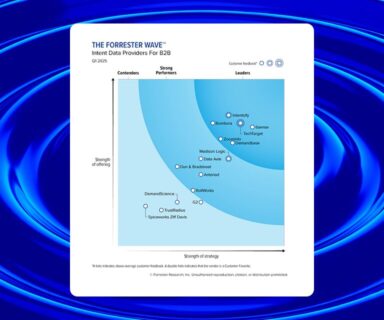 While today’s technology has digitally connected so many of us, it’s also made it difficult to get noticed by prospects. It’s become significantly harder for sales reps to get a hold of prospects using traditional sales methods such as cold calling. According to TOPO, it now takes 18+ calls to get noticed by a new buyer (source) – and even if reps are able to reach someone, it doesn’t mean they’ll even be receptive to the messaging. Since control in the modern buying process has shifted from seller to buyer, reps are having to get a bit more creative with their efforts. So, how exactly do they get the ball back in their court? Enter social selling.
While today’s technology has digitally connected so many of us, it’s also made it difficult to get noticed by prospects. It’s become significantly harder for sales reps to get a hold of prospects using traditional sales methods such as cold calling. According to TOPO, it now takes 18+ calls to get noticed by a new buyer (source) – and even if reps are able to reach someone, it doesn’t mean they’ll even be receptive to the messaging. Since control in the modern buying process has shifted from seller to buyer, reps are having to get a bit more creative with their efforts. So, how exactly do they get the ball back in their court? Enter social selling.
Where the Prospects Are
Social selling is defined as “the art of using social media to find, connect with, understand and nurture sales prospects” (source: Hootsuite). In this digital age, sellers need to be where their buyers are – and that’s on social media. Prospects are leaving a digital footprint behind on the web and this is a gold mine of key information for sales reps to take advantage of. Social feeds can reveal what makes prospective buyers tick including their pain points, interests and even events they’ll be attending. The best part is that most of this information can be obtained before contacting prospects, so reps can be fully equipped with the information needed to craft meaningful and personalized messages before reaching out.
Another benefit of being where prospects are, is simply that reps will have more access to them. One in three B2B professionals say social selling has increased the number of leads they’re able to work with (source: CSO Insights & Seismic). I know what you’re thinking – more leads don’t always equal better leads. But, with buyers laying out their interests and pain points for all to see on social media, it’s easy to get more insight on which leads are the right leads. This is indicated through the content that prospects are sharing on their feeds, as well as the posts they are engaging with. The insights uncovered from social selling can be used to nurture prospective buyers and even drive home a deal with buyers in the consideration phase.
How to Social Sell: Get Even More Personal with Your Prospects
One of the most appealing aspects of social selling is the plethora of valuable buying information it can uncover. While sources of behavioral data such as real purchase intent data can reveal key information such as contact details, purchase drivers, topical interests and competitive consideration, reps can round out their personal insight into prospects by incorporating information from social profiles. For instance, many people list organizations they volunteer for or hobbies they partake in on their social channels – information that isn’t typically available anywhere else. Areas where this information could live are social bios, activity or posting history (what they’re sharing and how often). In this digital age, sellers need to make conversations much more personal; and social selling shows you took the time to get to know a prospect on a human level before reaching out.
How to Social Sell: Less Talking, More Listening
There are a lot of conversations happening on social media, most of which buyers will never come to you directly to discuss. While this may be intimidating, it’s important that sales reps know exactly how prospects perceive the solution they are trying to sell. You can think of social media as a B2B buyer’s Yelp. This is where reps can discover both happy customers singing praises of their solution and dissatisfied ones critiquing their solution (hopefully more of the former). Either way, decision makers are looking to social to justify the big purchase they’re about to make. In addition to just staying in the know, reps can also contribute to these online conversations to develop a positive brand reputation and show that they are actively involved in the customer experience.
How to Social Sell: Curate Relevant Content
Since many prospects in the consideration stage are spending their time on social media, reps need to ensure they are sharing relevant content that shows their company’s solutions are effective. This is where it gets tricky – the content reps share should be a mix of thought leadership material and product focused material. The idea is to position yourself as an expert in the space and less like someone just trying to sell something (who would you rather follow?). While product-focused posts are important, be careful not to go overboard with them, as this behavior will get you unfollowed in no time. Instead, stay focused on resources that can help customers solve their problems. When building a repository of content to share, reps should consider sourcing content from experts and channels that buyers consult within a purchasing cycle, such as industry analysts, expert blogs and third party independent publishers.
Social Selling: Fuel Pipeline and Close More Business
In order to thrive in such a competitive market, sellers need to adapt to new times and be where their buyers are. According to Sales for Life, social selling can result in 40-50% more new business and 80-90% retention rates (source), so it’s worth investing the time in. The best way to socially appeal to prospects in your territory is to provide helpful resources and intelligence to guide them along their buying journey. All the while, reps can gain valuable insights from social profiles to help fuel their pipeline and push deals in the right direction.
—
Pair your social selling insights with information on active buyers in-market now. TechTarget’s Priority Engine provides third-party intent data on the topical interests, vendor consideration and installed technologies of accounts and connects you to actual members of the buying teams researching products like yours. Learn more: https://www.techtarget.com/products/priority-engine/.



